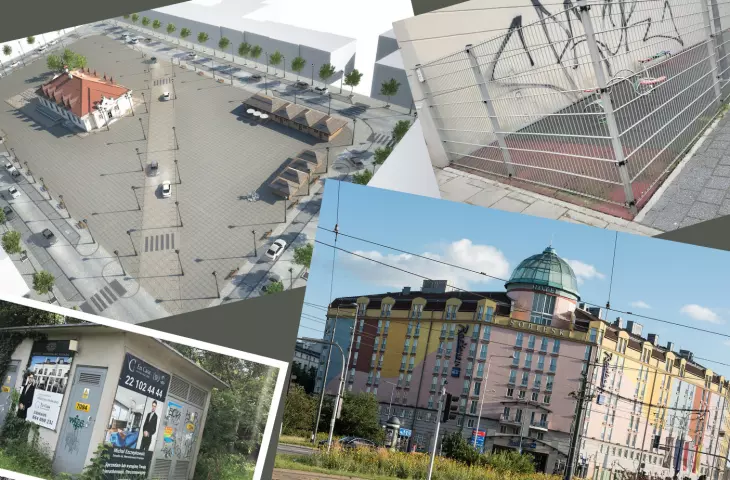I'd like to go for a walk in a cultural park that will never be built, and the moment we forget about its „aesthetic qualities” will be the day of final victory over the clamor of space for many.
Imagine walking down a crowded concreted street of a modern housing development, which overlooks windows on no more than ten square meters of luxury-type micro-apartments, involving the cost of a thirty-year mortgage.
As you walk down this concrete street, you pass a „playground” smaller in size than the aforementioned apartment, on which you pass a swing that was last used by someone more or less ever. You are slowly approaching the gate of a gated estate, from which it is impossible to exit any other way.
The playground, nominated in the „Krakow Archibubel” competition.
© Ulepszamy Kraków Association
Once you leave the housing estate, you'll be faced with a post-comunist estate painted in all the colors you could call non-neutral. Oranges, Pompeian pinks, blues and navy blues so unnatural that they make your eyes cross. The color race for aesthetic dazzle will be further laced with unlimited banners advertising warming, insecticides and another mediocre series on streaming. In short: pastelosis chases advertosis.
krakow example of the eradication of reklamosis
© Pogromcy reklamozy
Immediately after the blocks of flats, we will enter directly into the urban hot pan, which we will get to by walking through underground sewers, colloquially known as „underground passages”, which can only bring to mind post-apocalyptic film productions. However, once we are in the center of the city, which in Poland can be either dominated by tourists (a big city) or deserted (a small town), we enter the reheating and rapid-fire zone, which was decided to be done so that by chance some subsidy would not be lost. Once we've gone through all these varieties of closed settlements, advertisement, pastelosis, concretosis and underground, maybe it will dawn on us that it's not worth losing it someday and we'll establish a cultural park?
Zakliczyn market „revitalization” project
© Urząd Miasta Zakliczyn
a park that will never be built
Tinged with irony, the above vision is not something revelatory. Architektura & Bizes has been talking about all the problems with the Polish space for years. With every advertising resolution, the de-construction of another square or the euphoria resulting from small steps towards a better space, we rejoice greatly.
The vision of the disappearance of all these issues (not counting the much bigger problem of spatial chaos) is a beautiful one, but it nevertheless requires consideration right now. Should we, in some shape, leave the legacy of a pigeonholed Poland, the pastelose pouring out from all sides with its motley colors, or the cobblestones beloved by Polish authorities?
Warsaw's iconic hotel may also change its face—although such ideas are so far pure theory.
Photo: Adrian Gucyk | © Wikimedia Commons CC BY-SA 4.0.
Barely a few months have passed since the demolition of the Solpol, which for many years was considered Wroclaw's greatest architragedy, until (not by most) it was recognized as an important heritage of the city, which unfortunately was not appreciated in time. When voices are raised about painting the Sobieski Hotel a bland white instead of the mottling that is inherent in the building, there are voices of dissent.
Perhaps, once we banish advertisements with resolutions, decetonate the centers and replace the mottling with a less painful set of colors for the eyes, the thought will come that the legacy of the last thirty years is not only interesting architectural realizations or exceptionally successful spaces, but also a „shriek of space” and a „bathtub with a colonnade.” Skeptics may put the brakes on my enthusiasm for the preservation of grandfatherhood, seeing that this problem is so entrenched in our culture, and the first glimpses of change are fairly new, that the last examples of blandness will disappear in decades. Perhaps it is worth „not fixing” the world all at once, and somewhere to leave an example for the next generations, who will look with disbelief at what we have done to ourselves, even if it is a purely theoretical observation?
non-existent Wroclaw Solpol
Photo: Volens Nolens Kraplak | © Wikimedia Commons CC BY-SA 4.0




























